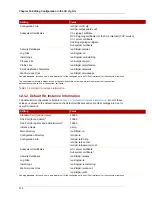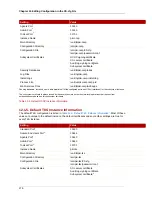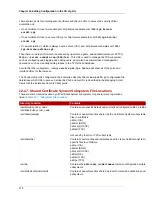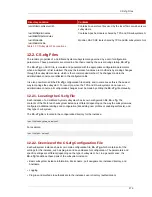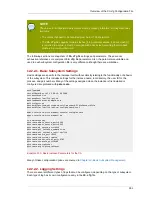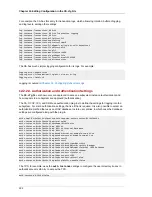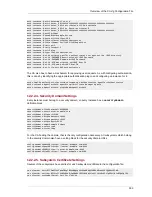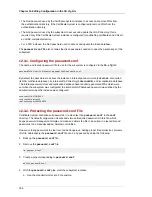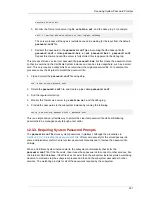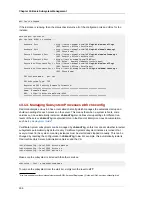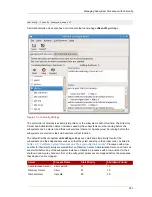
Chapter 12. Editing Configuration in the CS.cfg File
282
For example, the CA has this entry for transaction logs, which allows log rotation, buffered logging,
and log levels, among other settings:
log.instance.Transactions._000=##
log.instance.Transactions._001=## Transaction Logging
log.instance.Transactions._002=##
log.instance.Transactions.bufferSize=512
log.instance.Transactions.enable=true
log.instance.Transactions.expirationTime=0
log.instance.Transactions.fileName=/var/log/pki-ca/transactions
log.instance.Transactions.flushInterval=5
log.instance.Transactions.level=1
log.instance.Transactions.maxFileSize=2000
log.instance.Transactions.pluginName=file
log.instance.Transactions.rolloverInterval=2592000
log.instance.Transactions.type=transaction
The RA has much simpler logging configuration for its logs. For example:
logging.error.enable=true
logging.error.filename=/var/log/pki-ra/ra-error.log
logging.error.level=10
Logging is covered in
Chapter 15, Configuring Subsystem Logs
.
12.2.2.3. Authorization and Authentication Settings
The
CS.cfg
file sets how users are approved to access a subsystem instance (authorization) and
how requests to a subsystem are approved (authentication).
The CA, OCSP, TKS, and DRM use authorization plug-ins to define the settings for logging into the
subsystem. For some authorization settings, that is all that is required. It is also possible to select an
authorization method that uses an LDAP database to store user entries, in which case the database
settings are configured along with the plug-in.
authz.impl.DirAclAuthz.class=com.netscape.cms.authorization.DirAclAuthz
authz.instance.DirAclAuthz.ldap=internaldb
authz.instance.DirAclAuthz.pluginName=DirAclAuthz
authz.instance.DirAclAuthz.ldap._000=##
authz.instance.DirAclAuthz.ldap._001=## Internal Database
authz.instance.DirAclAuthz.ldap._002=##
authz.instance.DirAclAuthz.ldap.basedn=dc=server.example.com-pki-ca
authz.instance.DirAclAuthz.ldap.database=server.example.com-pki-ca
authz.instance.DirAclAuthz.ldap.maxConns=15
authz.instance.DirAclAuthz.ldap.minConns=3
authz.instance.DirAclAuthz.ldap.ldapauth.authtype=BasicAuth
authz.instance.DirAclAuthz.ldap.ldapauth.bindDN=cn=Directory Manager
authz.instance.DirAclAuthz.ldap.ldapauth.bindPWPrompt=Internal LDAP Database
authz.instance.DirAclAuthz.ldap.ldapauth.clientCertNickname=
authz.instance.DirAclAuthz.ldap.ldapconn.host=localhost
authz.instance.DirAclAuthz.ldap.ldapconn.port=389
authz.instance.DirAclAuthz.ldap.ldapconn.secureConn=false
authz.instance.DirAclAuthz.ldap.multipleSuffix.enable=false
The TPS, for example, uses the
auth.instance
settings to configure the user directory it uses to
authenticate users who try to access the TPS.
auth.instance.0.SSLOn=false
Summary of Contents for CERTIFICATE SYSTEM 8.0 - ADMINISTRATION
Page 42: ...20 ...
Page 43: ...Part I Setting up Certificate Services ...
Page 44: ......
Page 190: ...168 ...
Page 208: ...186 ...
Page 223: ...Part II Additional Configuration to Manage CA Services ...
Page 224: ......
Page 256: ...234 ...
Page 270: ...248 ...
Page 280: ...258 ...
Page 292: ...270 ...
Page 293: ...Part III Managing the Subsystem Instances ...
Page 294: ......
Page 408: ...386 ...
Page 438: ...416 ...
Page 439: ...Part IV References ...
Page 440: ......
Page 503: ...Netscape Defined Certificate Extensions Reference 481 OID 2 16 840 1 113730 13 ...
Page 504: ...482 ...
Page 556: ...534 ...
Page 564: ...542 ...







